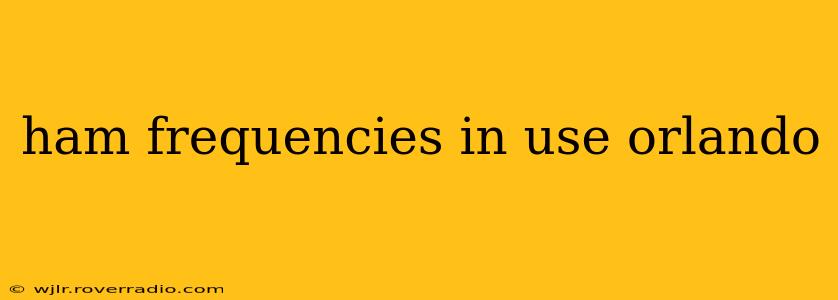Orlando, Florida, boasts a vibrant amateur radio community, with numerous hams active across various frequencies. Pinpointing exactly which frequencies are in use at any given moment is impossible; radio activity is dynamic and constantly changing. However, this guide will help you understand the typical frequencies used by Orlando-area hams and how to find active conversations.
Understanding Ham Radio Frequencies: A Quick Primer
Before we delve into Orlando-specific frequencies, let's clarify some basics. Amateur radio, or ham radio, operates on designated frequency bands allocated by the FCC (Federal Communications Commission). These bands are categorized by their frequency ranges and intended uses. You won't find specific "Orlando frequencies," but rather frequencies commonly used within the Orlando area by hams.
Common Ham Radio Bands Used in Orlando
Several bands are popular among Orlando hams, each with its own characteristics:
-
2 Meters (144-148 MHz): This is a very popular band for local communication, ideal for covering areas within and around Orlando. You'll find repeaters, simplex (direct communication without a repeater), and various activity, including local nets and emergency communications.
-
70 Centimeters (420-450 MHz): Similar to 2 meters, this band offers excellent local coverage and is often used for repeaters, simplex, and specialized communication needs. The higher frequency provides greater potential for digital modes.
-
HF Bands (below 30 MHz): These bands are used for long-distance communication, sometimes reaching across the globe. While less common for strictly local Orlando conversations, HF is crucial for long-range contacts and contests. Popular HF bands include 20 meters (14 MHz), 40 meters (7 MHz), and 80 meters (3.5 MHz). Propagation (the ability of radio waves to travel) plays a major role in HF communication and is dependent on solar activity and time of day.
How to Find Active Ham Radio Frequencies in Orlando
The best way to find active frequencies in Orlando is to:
- Use a Scanner: A ham radio scanner can monitor frequencies, allowing you to listen to various conversations and identify active channels.
- Listen to Repeaters: Repeaters extend the range of your transmissions. Online resources (like RepeaterBook.com) list repeaters in the Orlando area, showing their frequencies and input/output tones. Simply listen to these frequencies to see what's happening.
- Join a Local Ham Radio Club: Joining a local club provides access to experienced hams who can guide you toward active frequencies and local events. They'll have insights into current activity and best practices.
- Check Online Forums and Social Media: Online ham radio communities, forums, and social media groups specific to the Orlando area are valuable resources. Hams often share information about active frequencies and upcoming events.
What are common frequencies used for local communication in Orlando?
Local communication in Orlando primarily occurs on the 2-meter and 70-centimeter bands. Specific frequencies vary greatly depending on repeater systems in use. You'll need to refer to a repeater database like RepeaterBook.com to find local repeaters and their associated input and output frequencies. Simplex communication on these bands also occurs but typically covers shorter ranges.
What frequencies are used for long-distance communication from Orlando?
Long-distance communication from Orlando typically utilizes the HF bands (below 30 MHz), like 20 meters, 40 meters, and 80 meters. The success of long-distance communication depends heavily on propagation conditions. Conditions are unpredictable, varying with time of day, season, and solar activity. Many hams use HF for contesting and DXing (contacting stations far away).
Are there any specific frequencies used for emergency communication in Orlando?
While specific emergency frequencies aren't publicly advertised for security reasons, many Orlando-area hams participate in local emergency communication nets. These nets often utilize repeaters on 2 meters and 70 centimeters. Contacting your local ARRL (American Radio Relay League) chapter or emergency management agencies would be the best way to learn more about emergency communication procedures and frequencies in your specific area.
Remember: Always operate your ham radio legally and responsibly, adhering to all FCC regulations and licensing requirements. This information is for informational purposes only and is not a substitute for proper ham radio training and licensing.
